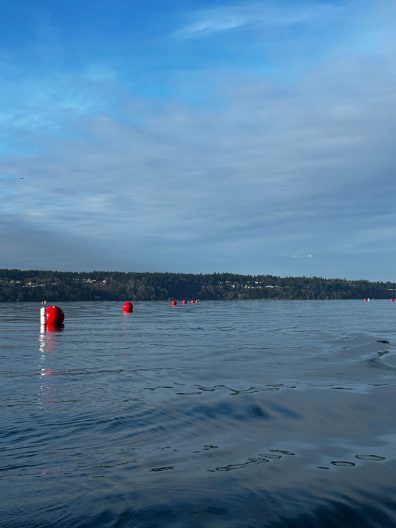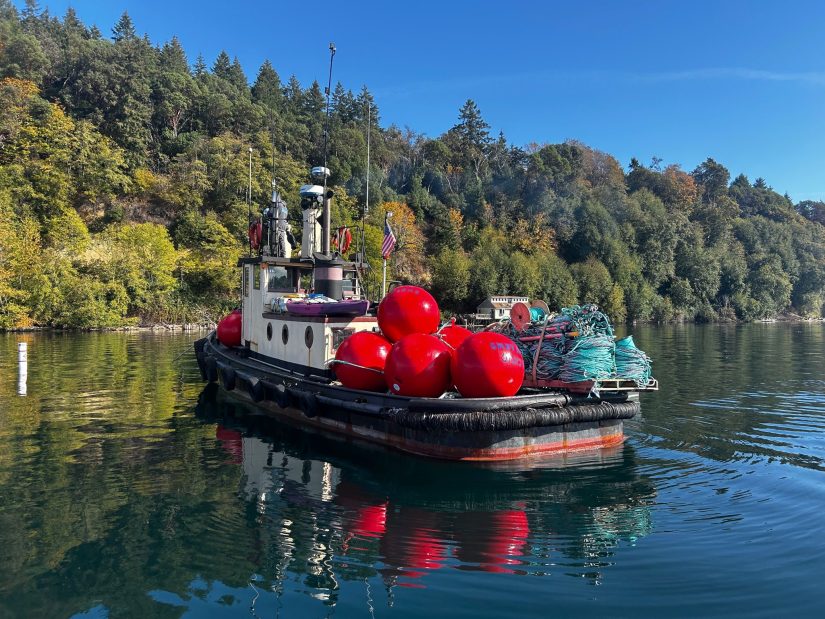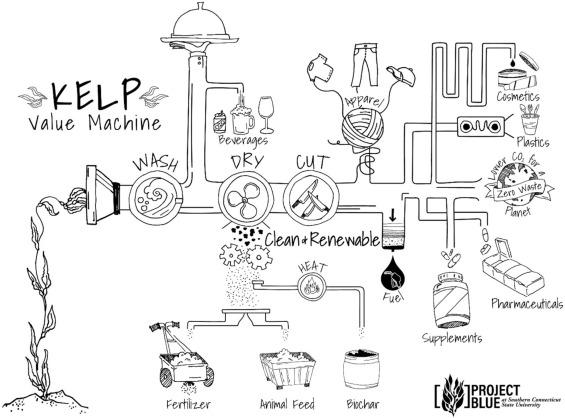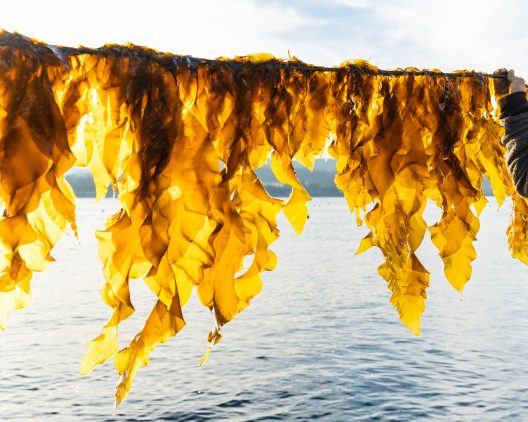Exploring Kelp Farming with Pacific Sea Farms
It’s a typical mid-November day on Vashon Island, with overcast skies and a mild, intermittent, chattering rain. The rocky beach is narrow—at high tide parts of it will be impassable on foot. Mike Spranger, who I first met through a kelp monitoring training program, leads the way. After rounding the corner of a concrete wall and carefully stepping through a few fallen trees, I finally see it: the kelp farm!

Mike, the founder of Pacific Sea Farms, explains that they just completed the installation earlier this month. The farm is relatively inconspicuous from land—if I wasn’t here to visit it, I don’t think I would have noticed it. Approximately 250 feet from shore are several red buoys forming the perimeter and one of the interior lines of a rectangular grid. Mike explains to me how each of the buoys fits into the overall farm structure. The farm is organized into three “arrays,” each one a collection of five grow lines spaced 125 feet apart and eight feet deep, running parallel to shore to minimize wave disruption, and with five evenly spaced buoys marking their location on the surface. The whole farm is held into place using six anchors and recycled concrete blocks that weigh thousands of pounds. Mike has already seeded twine with the microscopic stages of sugar kelp (Saccharina latissima) at his home hatchery. In a few weeks, he’ll unwind the seeded twine around the longline rope in his farm to “plant” the kelp. Sugar kelp is one of 26 kelp species native to Washington and grows rapidly through the winter and early spring. In late April or early May, the kelp will be six to ten feet long, resemble wavy lasagna noodles, and will be ready for harvest.
The farm installation is a landmark moment for Pacific Sea Farms and the entire kelp aquaculture industry in Washington state. There are only three in-water kelp farms in Washington: Blue Dot Sea Farms, Lummi Island SeaGreens, and now, Pacific Sea Farms. While seaweed farming is new to Washington, it’s an established industry globally. Six countries in Asia are responsible for 98% of the 35 million tons of seaweed harvested annually. Although seaweed is the fastest-growing aquaculture sector in the United States, the close to 100 active farms produce just 0.01% of the world’s seaweed. In the US, some of the challenges that limit the continued growth of the industry include a complex permitting process, lack of processing infrastructure, limited public support for seaweed farming, and finding an established, profitable market for seaweed products.
“In the US, some of the challenges that limit the continued growth of the industry include a complex permitting process, lack of processing infrastructure, limited public support for seaweed farming, and finding an established, profitable market for seaweed products.”
As I looked out at the gently bobbing buoys of the farm, I thought about the seaweed that would eventually grow beneath the water’s surface and how it could be used. Today, seaweed is used as food, fertilizer, animal feed additives, thickening agents, and in cosmetics. Additionally, there’s active research and development towards using it as a biofuel and to replace single-use plastics. There’s also significant hype in the news media about using large-scale seaweed farming as a means to sequester carbon and mitigate ocean acidification and coastal eutrophication. Are these claims substantiated by research? I wasn’t sure. To understand the implications of expanding seaweed farming in Washington, I needed to first level-set my expectations and separate reality from sensationalism.

First, how does farmed seaweed compare to land-based agriculture? Growing food on land is resource intensive: today, food production uses half of the world’s habitable land and accounts for 70% of freshwater use. Seaweed stands in sharp contrast to this—it requires no pesticides, fertilizer, or arable land and is grown with minimal-to-zero freshwater inputs, although, like traditional agriculture, it does require the use of fossil fuels to maintain the farm. Additionally, kelp farms can provide structure, food, and nutrient cycling during the growing season that may benefit wildlife by creating shelter, spawning locations, and foraging opportunities. When farmed responsibly, it’s one of the most environmentally sustainable methods of food production. This year, Mike plans to join the other Washington kelp farmers in selling his seaweed for human consumption.
“Seaweed requires no pesticides, fertilizer, or arable land and is grown with minimal-to-zero freshwater inputs.”
Many additional, established industries are also built around seaweeds today. One of the largest is the seaweed fertilizer and biostimulant industry. The World Bank estimates that the biostimulant market will grow from a 1-billion-dollar industry in 2023 to a 1.8-billion-dollar industry by 2030. Biostimulants are used as a replacement for, or in conjunction with, conventional fertilizers to mitigate stress and improve plant productivity. Synthetic fertilizers can degrade soil health over time, and runoff from these fertilizers can lead to adverse human health effects. Seaweed-based biostimulants improve microbial soil activity, create minimal runoff, can increase soil carbon, and can lead to better plant growth and higher crop yields. Another 1-billion-plus industry leverages seaweed’s goopy properties to create thickening, gelling, and emulsifying agents. Carrageenan, agar, and alginates are some of the most common seaweed derivatives and are also used in drug delivery and cosmetics. While it is possible to use sugar kelp extracts to create biostimulants and alginates, it’s worth noting that currently, neither industry primarily uses sugar kelp to create its products.
One emerging industry that could rely on seaweeds grown within the United States is using seaweeds to create compostable alternatives to single-use plastic products. According to the United Nations Environment Program, the packaging sector accounts for 36% of all plastics produced worldwide. Innovative startups today are creating seaweed-based packaging, utensils, and even fishing gear. One California-based startup, Sway, is partnering with the plastics industry and reusing existing infrastructure to create a seaweed-based resin that can be melted and formed into finished products. They expect to reach commercial volumes this year and already partner with US-based seaweed farms for sourcing.

So, seaweed is a lower carbon footprint food that can double as a fertilizer, thickening agents, and as ingredients in cosmetics and other products. Seaweed-based plastic replacements are beginning to penetrate the market. But what about the bolder claims that seaweed can assist with carbon sequestration, ocean acidification, and coastal eutrophication? Research into these areas is ongoing, and farmed seaweed’s possible role in mitigating these large-scale problems is limited and nuanced. Since kelp farming in the US is a nascent industry, overpromising these benefits could ultimately hinder industry growth and harm early investors and farmers.
Two areas where it’s imperative not to outpace research with bold claims about seaweed’s potential are carbon sequestration and ocean acidification. Seaweed naturally absorbs carbon as it grows. After the growing season, some wild seaweed finds its way to the deep sea, where the carbon remains sequestered for hundreds to millions of years. Today, seaweeds are estimated to sequester nearly 200 million tons of carbon dioxide annually, the equivalent of New York State’s annual emissions. For larger scale, intentional carbon sequestration, significant additional research is needed to understand better the practicalities (How do you ensure the seaweed sinks and remains down long enough? Can coastal species of kelp be grown effectively in the open ocean?), the ecological impacts, and the validity of carbon accounting methods. Sinking millions of tons of carbon-rich seaweed into the famously nutrient-poor deep ocean could drastically impact ocean ecosystems and biochemistry. Scale is also a concern. By midcentury, ten gigatons of carbon dioxide will need to be annually removed to meet international climate goals. Sequestering a measly 0.1 gigatons of carbon using seaweed would require over seven million hectares of ocean space, an area larger than the entire country of Ireland.
Similarly, the research shows that kelp farming has limited impacts on ocean acidification. As the ocean absorbs carbon dioxide from the atmosphere, chemical reactions occur that result in more acidic seawater and fewer available carbonate ions. Carbonate is used by tens of thousands of marine species to form their shells and skeletons. Ocean acidification is a threat to marine life, the food web, commercial fisheries, and food security. As kelp grows, it removes carbon dioxide from seawater, which results in less acidic water. Thus, many studies have investigated using kelp to reduce ocean acidification. Some have found that with the optimal environmental conditions, kelp can create local refugia from ocean acidification conditions, but none have found that kelp will have the large-scale impact needed to seriously address ocean acidification. Ultimately, the most effective way to limit ocean acidification is to drastically reduce carbon dioxide emissions.

Unsurprisingly, kelp farming is not a silver bullet that will single-handedly solve ocean acidification and climate change. However, this finding should not undermine the role kelp farming can play in a more sustainable and environmentally friendly future. Compared to traditional land-based agriculture, kelp is grown with few inputs. It can be transformed into food, fertilizer, feed additives, and cosmetics. Maybe one day soon, kelp will see widespread use as a replacement for petroleum based plastics or as biofuel. In the meantime, it sequesters carbon, provides habitat, and can improve local water quality. As the marine biologist Dr. Ayana Elizabeth Johnson eloquently states; “Instead of continuing to rely on fossil-fuel–intensive manufacture of fertilizers, we can farm seaweeds that suck up carbon as they grow and can be used for food, animal feed, biofuels, and fertilizer. Instead of pesticides making us and the ocean sick, we can grow food in the ocean that makes us well. Instead of fertilizer runoff creating algal blooms, we can use algae as fertilizer to make fruit trees bloom.”
As I reflect on my visit to Pacific Sea Farms, it’s clear to me that supporting a local kelp farm and innovative new seaweed-based products is an opportunity to invest in our future on a healthier, more sustainable planet. I’m hopeful for Mike’s first harvest at Pacific Sea Farms, and hopeful that the kelp industry in Washington, just like the sugar kelp on his lines, will continue to grow.